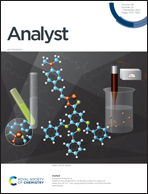Turning waste into treasure: chicken eggshell membrane derived fluorescent carbon nanodots for the rapid and sensitive detection of Hg2+ and glutathione†
Abstract
Herein, a green, economical, and waste-utilization approach is reported for the synthesis of water-soluble carbon nanodots (C-Dots) with a high fluorescence quantum yield of 19.5%. As a common protein-rich waste, eggshell membrane was selected as a cost-effective and ideal precursor to prepare C-Dots using the microwave method. The as-prepared C-Dots showed a maximum emission at 375 nm with an excitation wavelength at 235 nm. The fluorescent C-Dots were adopted as a sensitive probe for the rapid detection of Hg2+ and glutathione (GSH) based on the fluorescence off and on (turn-off–on) strategy. This was ascribed to the fact that Hg2+ could effectively quench the fluorescence of the C-Dots and GSH was able to prevent fluorescence quenching owing to the specific binding between Hg2+ and GSH. The designed method exhibited a high sensitivity and selectivity towards the detection of Hg2+ and GSH. Under the optimized conditions, the method showed a good linear relationship with Hg2+ concentration in the range from 100 nM to 50 μM with a detection limit of 32.0 nM. For GSH detection, it displayed a linear range from 50 nM to 10 μM with a detection limit of 9.8 nM. Moreover, this method was successfully applied to detect GSH in human serum samples. The eggshell derived fluorescent C-Dots pave the way for economical environmental and biological analyses.



 Please wait while we load your content...
Please wait while we load your content...